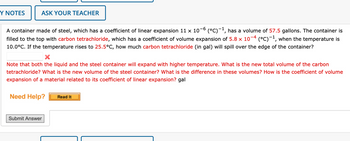Question

Transcribed Image Text:Y NOTES
ASK YOUR TEACHER
A container made of steel, which has a coefficient of linear expansion 11 x 10−6 (°C)−¹, has a volume of 57.5 gallons. The container is
filled to the top with carbon tetrachloride, which has a coefficient of volume expansion of 5.8 x 10-4 (°C) -¹, when the temperature is
10.0°C. If the temperature rises to 25.5°C, how much carbon tetrachloride (in gal) will spill over the edge of the container?
X
Note that both the liquid and the steel container will expand with higher temperature. What is the new total volume of the carbon
tetrachloride? What is the new volume of the steel container? What is the difference in these volumes? How is the coefficient of volume
expansion of a material related to its coefficient of linear expansion? gal
Need Help?
Submit Answer
Read It
Expert Solution
This question has been solved!
Explore an expertly crafted, step-by-step solution for a thorough understanding of key concepts.
This is a popular solution
Trending nowThis is a popular solution!
Step by stepSolved in 3 steps with 2 images

Knowledge Booster
Similar questions
- An aluminium ring with a hole having area 4.02 cm² is to be shrink fitted on a steel rod with cross sectional area of 4.04 cm2. Both rod and ring were initially measure at a temperature of 35.0 °C. At what common temperature will the aluminium ring be exactly the same size as the steel rod? The measured coefficient of thermal expansion of steel is 11.0x10-6 K1 and the measured coefficient of thermal expansion of aluminium is 24.0x10-6 x-1.arrow_forwardA metal rod had a coefficient of linear expansion α = 1.5 x 10-5 1/K. It has a starting length of 210 cm. When the temperature changes from 25 °C to 55 °C, by how much does the length of the rod change, in cm?arrow_forwardA mountain hiker tightens the cap on a half-full plastic water bottle at a high altitude. The volume of air in the sealed bottle is 5 x 10-4 m³, the pressure is 64 kPa and the temperature is -8 °C. The hiker descends to a lower altitude where the pressure is 94.2 kPa and the temperature is 11 °C. What is the final volume of the sealed air inside the bottle? (this is what causes the plastic bottle to deform if you've ever experience this situation)arrow_forward
- 3 E 2. A concrete highway is built of slabs 19.0 m long (at 23 °C). How wide should the expansion cracks be (at 23 °C) between the slabs to prevent buckling if the annual extreme temperatures are -37 °C and 52 °C?(the coefficient of linear expansion of concrete is 1.20 x 10-5 °C-¹) meters D # L 835 ه R % F الله ساك 5 V B T G 6 MacBook Air --- B & 7 I 8 N FB 0 ا K M 2 هوarrow_forward= A steel rod with a length of I 1.55 m and a cross section of A = 3.04 cm² is held fixed at the end points of the rod. What is the size of the force developing inside the steel rod when its temperature is raised by AT = 25.0 K? The coefficient of linear expansion for steel is a = 1.17x10-5 1/K, and the Young modulus of steel is E = 200.0 GPa. Submit Answer Tries 0/12arrow_forwardS. At a temperature of 22.20°C the hole in a steel plate has a diameter of 1.030 cm. If a steel rod with a diameter of 1.038 cm has to just slip through this hole, to what temperature should the plate be heated? The coefficient of area expansion of steel is 24 X 10 -6/ °C. Ans: 672arrow_forward
- If you have 0.251 m³ of water at 25.0 °C in an insulated container and add 0.112 m³ of water at 95.0 °C, what is the final temperature T; of the mixture? Use 1000 kg/m³ as the density of water at any temperature. °C Tf =arrow_forwardAt a temperature of 22.00°C the hole in a steel plate has a diameter of 1.030 cm. If a steel rod with a diameter of 1.037 cm has to just slip through this hole, to what temperature should the plate be heated? The coefficient of area expansion of steel is 24 x 10-6/°C. °Carrow_forward
arrow_back_ios
arrow_forward_ios